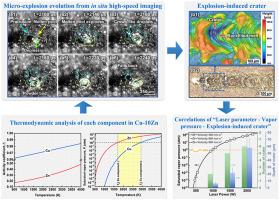International Journal of Machine Tools and Manufacture ( IF 14.0 ) Pub Date : 2020-12-19 , DOI: 10.1016/j.ijmachtools.2020.103686 Jie Yin , Wenqi Zhang , Linda Ke , Huiliang Wei , Dengzhi Wang , Liangliang Yang , Haihong Zhu , Peng Dong , Guoqing Wang , Xiaoyan Zeng

|
Vaporization of alloying elements is an important phenomenon during laser powder bed fusion (LPBF), especially in the laser interaction with difficult-to-form materials containing the volatile element as main alloying element, which has a significant effect on the chemical composition, microstructure and mechanical properties. However, the mechanisms of the typical phenomenon in vaporization, such as the explosion, and its influence on the forming quality are not fully understood. Here, based on the in situ high-speed high-resolution imaging, we observe the explosion of the molten pool with temporal scale of ~101 μs and spatial scale of ~101–102 μm during LPBF of Cu–10Zn. This micro-explosion can be attributed to the drastic augment of the saturated vapor pressure of Zn component in the molten pool. Theoretical calculations of vaporization amount in the explosion process by Miedema's model and Langmuir's equation, are agreed well with the experimental results of volume increment for vaporization-induced inflation of the droplet spattering. Moreover, we also reveal a new defect formation mechanism, explosion-induced crater, which is detrimental to the forming quality in LPBF. The explosion-induced crater defect can be mitigated by increasing the lifetime of the molten pool, thus improve the continuity and flatness of the melt track. This study is expected to provide the scientific basis for LPBF of difficult-to-form materials to achieve stable forming with fewer defects.
中文翻译:

Cu-10Zn合金激光粉末床熔合过程中合金元素的汽化和爆炸行为
合金元素的汽化是激光粉末床熔合(LPBF)期间的重要现象,尤其是在与难挥发的以挥发性元素为主要合金元素的材料的激光相互作用中,这对化学成分,微观结构和机械性能。但是,尚未完全了解汽化中典型现象(例如爆炸)的机理及其对成型质量的影响。在此,基于原位高速高分辨率成像,我们观察熔池的爆炸以〜10的时间尺度1微秒和10〜空间尺度1 -10 2 Cu-10Zn的LPBF期间的μm。这种微爆炸可归因于熔池中Zn组分的饱和蒸气压的急剧增加。利用Miedema模型和Langmuir方程,计算了爆炸过程中汽化量的理论值,与汽化引起的液滴飞溅膨胀的体积增加的实验结果吻合。此外,我们还揭示了一种新的缺陷形成机制,即爆炸引起的弹坑,这对LPBF的形成质量是有害的。可以通过增加熔池的寿命来减轻爆炸引起的火山口缺陷,从而提高熔体轨迹的连续性和平坦度。这项研究有望为难成型材料的LPBF提供科学依据,从而实现具有较少缺陷的稳定成型。











































 京公网安备 11010802027423号
京公网安备 11010802027423号